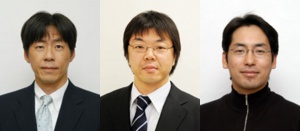A Half-metallic A- and B-site-ordered Quadruple Perovskite Oxide CaCu3Fe2Re2O12 with Large Magnetization and a High Transition Temperature
|
Published in “Nature Communications“(Online Publication, May 22, 2014). |
Prof. Shimakawa, Y., Assist Prof. Kan, D., Assist prof. Saito, T(from Left) |
||||
|
Dr. Chen, W.-T., Mr. Seki, H. (Ph D student), Assist Prof. Saito, T., Assist Prof. Kan, D., and Prof. Shimakawa, Y. (International Research Center for Elements Science, Advanced Solid State Chemistry Laboratory)
Dr. Mizumaki, M. (Japan Synchrotron Radiation Research Institute, SPring-8)
Dr. Senn, M. S., Prof. Attfield. J. P. (Centre for Science at Extreme Conditions and School of Chemistry, University of Edinburgh, UK) |
|||||
| Dr. Wei-tin Chen, Mr. Hayato Seki (Ph D student), Assistant Professor Takashi Saito, Assistant Professor Daisuke Kan, and Professor Yuichi Shimakawa in Institute for Chemical Research found a new half-metallic A- and B-site-ordered quadruple perovskite oxide CaCu3Fe2Re2O12. | |||||
|
Strong correlation between spins and conduction electrons is key in spintronic materials and devices. A few ferro- or ferri-magnetic transition metal oxides such as La1-xSrxMnO3, Fe3O4, CrO2, and Sr2FeMoO6 have spin-polarized conduction electrons at room temperature, but it is difficult to find other spin-polarized oxides with high Curie temperatures (well above room temperature) and large magnetizations for spintronics applications. Here we show that an A-and-B-site-ordered quadruple-perovskite oxide, CaCu3Fe2Re2O12, has spin-polarized conduction electrons and is ferrimagnetic up to 560 K. The couplings between the three magnetic cations lead to the high Curie temperature, a large saturation magnetization of 8.7 μB, and a half-metallic electronic structure, in which only minority-spin bands cross the Fermi level, producing highly spin-polarized conduction electrons. Spin-polarization is confirmed by an observed low-field magnetoresistance effect in a polycrystalline sample. Optimization of CaCu3Fe2Re2O12 and related quadruple-perovskite phases is expected to produce a new family of useful spintronic materials. |
|||||
|
Figure 1. Crystal and magnetic structures of CaCu3Fe2Re2O12 and its magnetic property. |
|||||
| The work was done in collaboration with Dr. Masaichiro Mizumaki (Japan Synchrotron Radiation Research Institute, SPring-8) and Dr. Mark S. Senn and Prof. J. Paul Attfield (Centre for Science at Extreme Conditions and School of Chemistry, University of Edinburgh, UK). | |||||
| This work was supported by Grants-in-Aid for Scientific Research (Nos. 19GS0207 and 22740227), by a grant for the Joint Project of Chemical Synthesis Core Research Institutions from MEXT, and by a JST-CREST program of Japan. Part of the work was performed under the Strategic Japanese-UK Cooperative Program by JST and ESPRC and under the young researchers exchange program of ICR, Kyoto University. Support was also provided by EPSRC, STFC and the Royal Society, UK. | |||||
 Institute for Chemical Research, Kyoto University
Institute for Chemical Research, Kyoto University International Joint Usage Research Center
International Joint Usage Research Center
